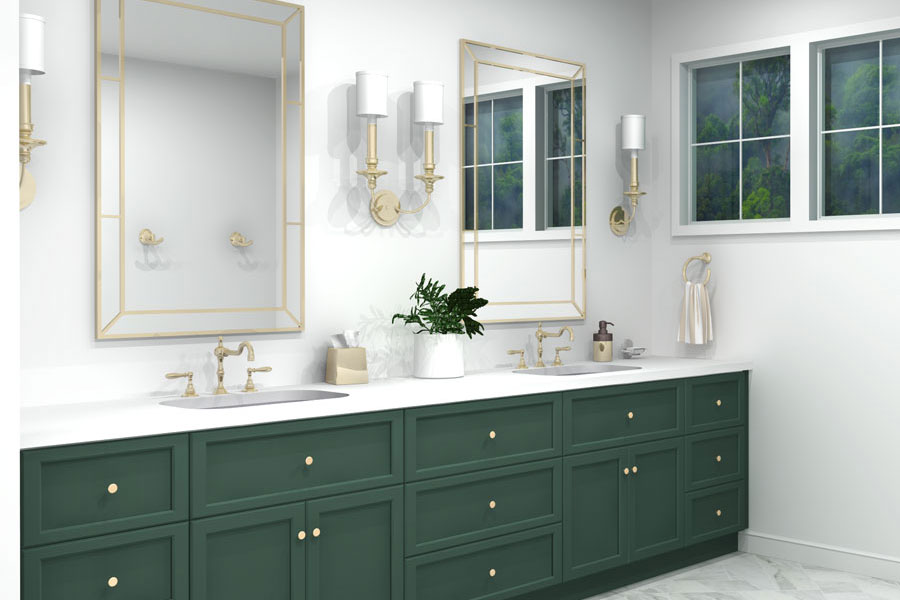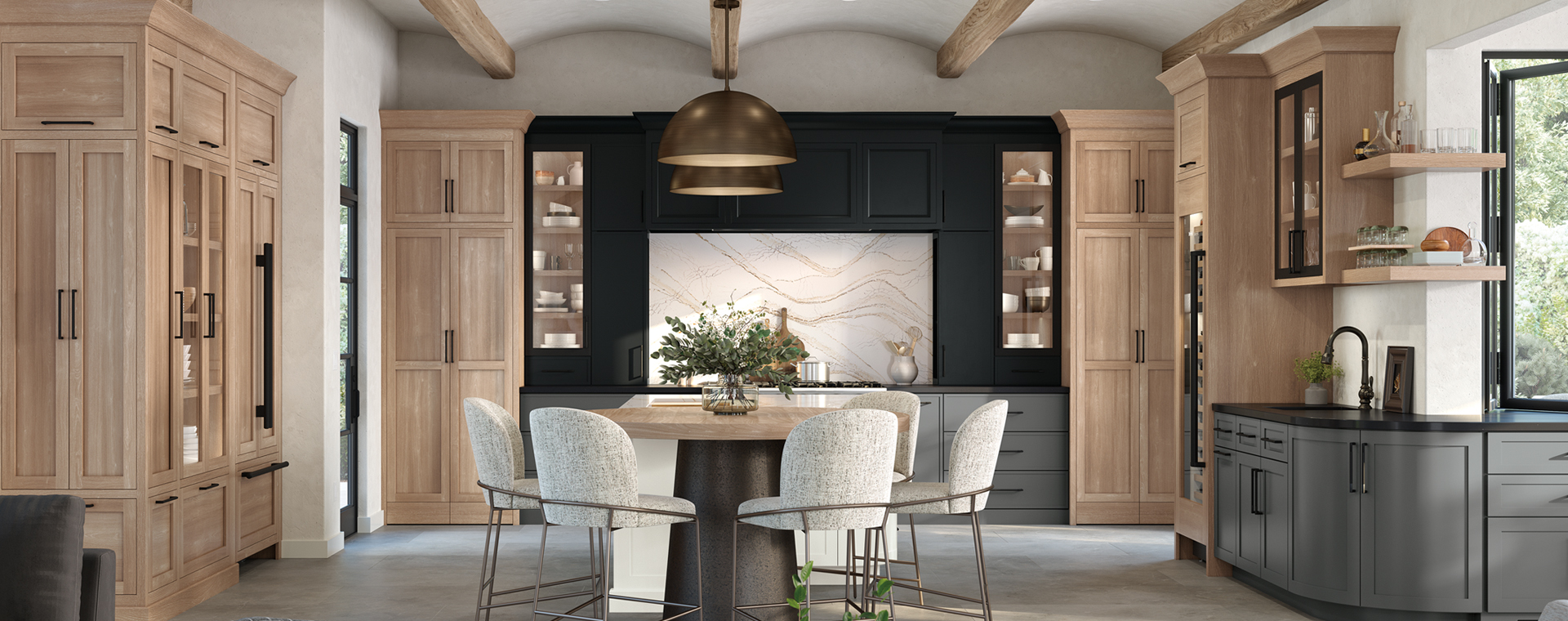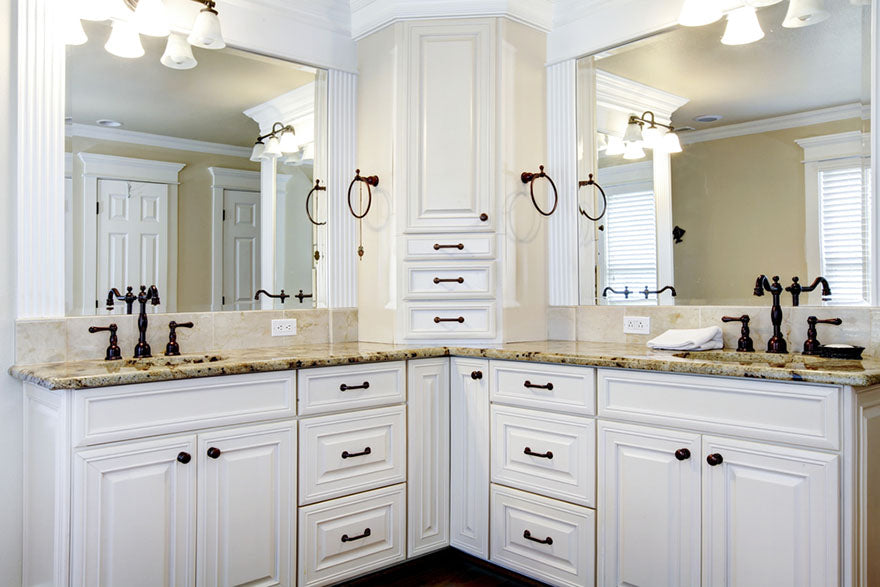Kitchen cabinets are designed for food storage and preparation. Bathroom cabinets are tailored for toiletries and personal care items.
Kitchen and bathroom cabinets serve distinct purposes and are built accordingly. Kitchen cabinets often feature deep drawers, pantry space, and specialized compartments for appliances and utensils. They are designed to withstand the demands of cooking and food storage. Bathroom cabinets, on the other hand, focus on optimizing space for toiletries, towels, and cleaning supplies.
They tend to be more moisture-resistant due to the humid environment. Materials used in kitchen cabinets may not always be suitable for bathrooms and vice versa. Choosing the right type of cabinet ensures functionality, durability, and aesthetic appeal in both spaces. Proper cabinet selection enhances the efficiency and organization of your home.

Credit: inspiredkitchendesign.com
Table of Contents
ToggleMaterials Used
Choosing the right materials for kitchen and bathroom cabinets is crucial. It impacts durability, maintenance, and aesthetics. Each space has unique needs and challenges, influencing material choice. Let’s explore the materials commonly used in these areas.
Common Kitchen Materials
Kitchens experience high traffic and exposure to heat and moisture. This demands durable and heat-resistant materials.
- Solid Wood: Classic and durable, solid wood suits traditional kitchens. Popular choices include oak, maple, and cherry.
- Plywood: Made from layers of wood veneer, plywood is strong. It resists warping and is cost-effective.
- MDF (Medium Density Fiberboard): MDF is smooth and affordable. It is ideal for painted finishes but less water-resistant.
- Particleboard: Economical and lightweight, particleboard is often used in budget-friendly kitchens. It is less durable than plywood.
- Stainless Steel: Offers a modern look and is easy to clean. Ideal for contemporary kitchens.
Common Bathroom Materials
Bathrooms are high-moisture environments. Materials must be water-resistant and mold-resistant.
- PVC (Polyvinyl Chloride): Waterproof and affordable, PVC is low-maintenance. It is available in various finishes.
- Marine Plywood: Treated to resist moisture, marine plywood is durable. It is ideal for humid bathrooms.
- Solid Surface: Non-porous and easy to clean, solid surfaces resist stains and mold. Popular brands include Corian and Avonite.
- Melamine: Coated with a plastic finish, melamine is water-resistant. It is available in many colors and patterns.
- Laminate: Durable and budget-friendly, laminate resists moisture. It is ideal for modern bathroom designs.
Choosing the right materials ensures the longevity and functionality of cabinets. It also enhances the beauty of your kitchen and bathroom.

Credit: www.omegacabinetry.com
Durability Factors
Understanding the durability factors of kitchen and bathroom cabinets is crucial. These cabinets face different environmental conditions, affecting their lifespan. Let’s dive into key aspects like moisture resistance and wear and tear.
Moisture Resistance
Kitchen cabinets often encounter spills, steam, and cooking splashes. These require materials that resist water damage. Common choices include:
- Laminate: Affordable and water-resistant.
- Solid Wood: Treated to resist moisture.
- Plywood: Strong and water-resistant when sealed.
Bathroom cabinets face high humidity and direct water exposure. This demands materials with superior moisture resistance. Preferred materials include:
- Medium-Density Fiberboard (MDF): Engineered to resist humidity.
- Thermofoil: Coated to withstand water and heat.
- Marine-Grade Plywood: Top-notch moisture resistance.
Wear And Tear
Kitchen cabinets endure constant use, from opening drawers to slamming doors. Materials must be tough and durable. Optimal choices are:
- Hardwood: Resilient to dents and scratches.
- Melamine: Scratch-resistant and easy to clean.
- Stainless Steel: Highly durable and hygienic.
Bathroom cabinets deal with frequent contact with water and hygiene products. They need to withstand wear and tear effectively. Suitable materials include:
- High-Density Fiberboard (HDF): Strong and water-resistant.
- Acrylic: Durable and easy to maintain.
- Veneer: Adds durability and aesthetic appeal.
| Material | Kitchen | Bathroom |
|---|---|---|
| Laminate | ✔️ | ❌ |
| Solid Wood | ✔️ | ✔️ |
| MDF | ❌ | ✔️ |
| Stainless Steel | ✔️ | ❌ |
Design Styles
Design styles for kitchen and bathroom cabinets differ significantly. Each space serves a unique purpose, requiring distinct aesthetics and functionalities. Understanding these differences helps in making informed decisions about your home’s interior design.
Popular Kitchen Designs
Kitchens are the heart of the home. Cabinet designs often reflect a blend of functionality and style. Below are some popular kitchen cabinet design styles:
- Shaker Style Cabinets: Known for their simple, clean lines. These cabinets have a classic look that suits various kitchen themes.
- Flat-Panel Cabinets: Also called slab cabinets. These have a modern and sleek appearance, ideal for contemporary kitchens.
- Beadboard Cabinets: Feature vertical planks, adding a rustic or cottage feel to the kitchen.
- Glass-Front Cabinets: Perfect for displaying dishes and glassware. They add an element of sophistication.
- Distressed Cabinets: Give an antique look. These are popular in farmhouse and vintage kitchen designs.
Popular Bathroom Designs
Bathroom cabinets need to be both practical and stylish. They should withstand moisture and provide ample storage. Here are some popular bathroom cabinet styles:
- Floating Cabinets: Mounted on the wall, creating a modern, airy feel. These are great for small bathrooms.
- Open Shelving: Offers easy access to towels and toiletries. Adds a spa-like vibe to the bathroom.
- Vanity Cabinets: Combine a sink with storage space. These are versatile and come in various designs.
- Medicine Cabinets: Often mounted above the sink. They provide storage for small items and sometimes include a mirror.
- Linen Cabinets: Tall cabinets that provide extra storage for linens and other bathroom essentials.
Storage Solutions
Effective storage solutions are essential in both kitchens and bathrooms. While both spaces require organization, the storage needs differ. In this section, we will discuss the distinct storage solutions for kitchen and bathroom cabinets.
Kitchen Storage Options
Kitchen cabinets need to store various items. These include cookware, utensils, and pantry staples. There are several types of kitchen storage options:
- Base Cabinets: These are placed below the countertop. They store heavy pots and pans.
- Wall Cabinets: These are mounted above the countertop. They are perfect for dishes and glassware.
- Pantry Cabinets: These tall cabinets can store non-perishable food items.
- Drawers: Ideal for cutlery, utensils, and smaller kitchen gadgets.
Bathroom Storage Options
Bathroom cabinets focus on different storage needs. They store toiletries, towels, and cleaning supplies. Below are common bathroom storage options:
- Vanity Cabinets: These are placed under the sink. They store toiletries and cleaning supplies.
- Medicine Cabinets: These are often wall-mounted. They store medicines and first-aid items.
- Linen Closets: These tall cabinets store towels and extra linens.
- Open Shelves: Great for displaying decorative items and storing frequently used items.
Choosing the right storage solutions for your kitchen and bathroom can enhance organization. It can make your daily routines more efficient and enjoyable.
Installation Differences
The installation of kitchen and bathroom cabinets varies due to their unique purposes and environments. Understanding these installation differences ensures a functional and aesthetically pleasing space.
Kitchen Installation
Kitchen cabinets need to be durable and spacious. They are installed at a height that provides easy access to cooking utensils and ingredients.
- Base Cabinets: Installed on the floor, supporting countertops.
- Wall Cabinets: Mounted on walls, offering additional storage.
- Tall Cabinets: Reach from floor to ceiling for pantry storage.
Proper alignment is crucial. Use a level to ensure cabinets are even. Secure cabinets to wall studs using screws. This prevents sagging and ensures stability.
| Type | Installation Height |
|---|---|
| Base Cabinets | 34-36 inches above floor |
| Wall Cabinets | 18 inches above countertop |
| Tall Cabinets | Floor to ceiling |
Bathroom Installation
Bathroom cabinets are designed for smaller items. Their installation focuses on maximizing space in a humid environment.
- Vanity Cabinets: Under the sink, providing storage for toiletries.
- Medicine Cabinets: Mounted on the wall, often above the sink.
- Linen Cabinets: Tall, narrow cabinets for towels and linens.
Ensure cabinets are moisture-resistant. Secure them to wall studs to prevent water damage. Use caulk around edges to keep water out.
| Type | Installation Height |
|---|---|
| Vanity Cabinets | 32-34 inches above floor |
| Medicine Cabinets | Eye level |
| Linen Cabinets | Floor to ceiling |

Credit: www.thewcsupply.com
Cost Considerations
Understanding the cost differences between kitchen cabinets and bathroom cabinets is crucial. This helps in budgeting for your renovation projects. Let’s dive into the cost factors for each.
Budgeting For Kitchens
Kitchen cabinets are often more expensive. They cover larger areas and require more materials.
- Materials: Wood, laminate, or metal. Wood is usually pricier.
- Customization: Custom cabinets cost more. Stock cabinets are cheaper.
- Hardware: Handles and knobs add to the cost.
- Installation: Professional installation ensures quality but adds to expenses.
Average costs for kitchen cabinets range from $5,000 to $20,000.
| Type | Cost |
|---|---|
| Stock | $5,000 – $10,000 |
| Semi-Custom | $10,000 – $15,000 |
| Custom | $15,000 – $20,000 |
Budgeting For Bathrooms
Bathroom cabinets are generally smaller and cost less. They usually require fewer materials.
- Materials: Wood, laminate, and MDF. MDF is the cheapest option.
- Customization: Custom bathroom cabinets can be costly.
- Hardware: Fewer handles and knobs mean lower costs.
- Installation: Installation costs are usually lower than kitchens.
Average costs for bathroom cabinets range from $1,000 to $5,000.
| Type | Cost |
|---|---|
| Stock | $1,000 – $2,000 |
| Semi-Custom | $2,000 – $3,500 |
| Custom | $3,500 – $5,000 |
Maintenance Needs
Understanding the maintenance needs of kitchen and bathroom cabinets is essential. Each type of cabinet has unique cleaning requirements. Proper maintenance ensures durability and aesthetic appeal.
Cleaning Kitchen Cabinets
Kitchen cabinets face grease and food splatters daily. Regular cleaning prevents build-up and keeps cabinets looking fresh. Follow these steps:
- Wipe cabinets with a damp cloth.
- Use a mild detergent for stubborn stains.
- Avoid abrasive cleaners that damage the finish.
- Dry cabinets with a soft towel to prevent water damage.
Cleaning Bathroom Cabinets
Bathroom cabinets are exposed to moisture and humidity. This exposure can cause mold and mildew. Follow these tips for bathroom cabinet maintenance:
- Wipe cabinets with a dry cloth daily.
- Use a vinegar solution to disinfect surfaces.
- Ensure proper ventilation to reduce moisture.
- Check for water damage regularly.
Expert Recommendations
When selecting cabinets for kitchens and bathrooms, expert advice can be invaluable. These tips ensure you make the right choice for both functionality and aesthetics. Below are expert recommendations to guide you in choosing the right cabinets and making a long-term investment.
Choosing The Right Cabinet
Choosing the right cabinet involves understanding the specific requirements of each room. Kitchen cabinets need to be durable and spacious. They should withstand heavy use and store various items like food, utensils, and cookware.
- Material: Opt for hardwood or plywood for kitchen cabinets.
- Storage: Ensure ample space for pots, pans, and small appliances.
- Durability: Choose finishes that resist stains and moisture.
Bathroom cabinets have different needs. They must handle high humidity and frequent cleaning. Functionality and size are crucial for storing toiletries and cleaning supplies.
- Material: Use materials like MDF or thermofoil that resist moisture.
- Storage: Look for cabinets with drawers and shelves for easy access.
- Durability: Pick finishes that withstand water and soap exposure.
Long-term Investment
Investing in high-quality cabinets pays off in the long run. For kitchen cabinets, solid wood or plywood offers the best longevity. These materials can withstand wear and tear for years.
| Kitchen Cabinets | Bathroom Cabinets |
|---|---|
| Solid wood or plywood | MDF or thermofoil |
| High durability | Moisture-resistant |
| Ample storage space | Compact and functional |
Bathroom cabinets should focus on materials that resist moisture and humidity. MDF and thermofoil are great choices. They ensure your cabinets remain in good condition for many years.
Quality finishes also play a significant role. Investing in high-quality finishes prevents damage and extends the life of your cabinets. Consider finishes that offer resistance to scratches, stains, and moisture.
Expert recommendations can help you select the best cabinets for your kitchen and bathroom. Focus on materials, storage, and durability to make a smart, long-term investment.
Frequently Asked Questions
What Are Kitchen Cabinets Made Of?
Kitchen cabinets are often made from wood, MDF, or plywood, offering durability and aesthetic appeal.
Are Bathroom Cabinets Different From Kitchen Cabinets?
Yes, bathroom cabinets are typically more moisture-resistant to withstand the humid environment.
Can Kitchen Cabinets Be Used In Bathrooms?
Not recommended. Kitchen cabinets lack the moisture resistance needed for bathroom environments.
Do Bathroom Cabinets Need Special Materials?
Yes, they often use moisture-resistant materials like PVC or treated wood.
How Do Cabinet Sizes Differ?
Kitchen cabinets are usually larger, offering more storage compared to the typically smaller bathroom cabinets.
Are Bathroom Cabinets More Moisture-resistant?
Yes, bathroom cabinets are designed to withstand high humidity and frequent exposure to water.
What Hardware Is Used In Kitchen Cabinets?
Kitchen cabinets commonly use robust hinges and drawer slides to handle frequent use and heavier loads.
Can I Customize My Bathroom Cabinets?
Absolutely, bathroom cabinets can be customized to fit specific dimensions and design preferences.
Do Kitchen Cabinets Come In Standard Sizes?
Yes, kitchen cabinets come in standard sizes for easy installation and replacement.
Why Do Bathroom Cabinets Cost More?
Bathroom cabinets often use specialized materials and finishes to resist moisture, which can increase costs.
Conclusion
Understanding the differences between kitchen and bathroom cabinets helps in making informed choices for your home. Each type of cabinet is designed with specific functions and requirements. By considering materials, size, and moisture resistance, you can ensure longevity and efficiency.
Make the right choice to enhance your home’s functionality and aesthetics.


